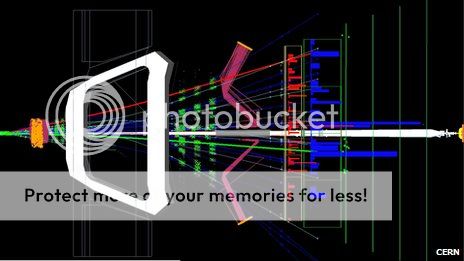- Joined
- Jul 28, 2007
- Messages
- 3,327
- Reaction score
- 3,055

Collided protons turn into, for example, Bs mesons, pions and kaons
The quest to understand why our Universe is made of matter rather than antimatter has received a boost at the Large Hadron Collider.
The LHCb experiment has for the first time observed decays of particles known as Bs mesons that preferentially end up as matter, rather than antimatter.
However, the difference is still not enough to explain the preponderance of matter over antimatter in the cosmos.
The work, published online, has been submitted to Physical Review Letters.
Every member of the zoo of particles we know about has an antimatter cousin, identical in every way except for an opposite electric charge - the electrons and protons that in part make us up have positrons and antiprotons as their antimatter matches.
The current theory for how the Universe got its start holds that equal amounts of matter and antimatter were initially created. But whenever the two meet, they destroy each other in a flash of light.
Simply put, the Universe should have come to a blazing end just then. Something must have made for a slight excess of matter in order to lead to the matter-dominated Universe we see today.
It is the subtle details of this preference for matter that the LHCb experiment is hunting for as it tracks particles created when protons are smashed together.
Just like the long-running hint for the particle called the Higgs boson, clues arise in the showers of particles created by these violent collisions.
'Puzzle continues'
Previous work at the LHCb had seen hints of an excess of matter - called CP violation - in combinations of the fundamental particles called quarks.
At other experiments around the world, the family of particles called mesons had been tackled, and small amounts of CP violation had been seen in two of the four meson types that have no electric charge.
A third type, D0 mesons, showed early hints of CP violation at LHCb in 2011, but more recent studies suggest those hints were mistaken.
LHCb detector LHCb, one of six experiments at the LHC, is dedicated to these kinds of studies
The new work considered the fourth: Bs mesons. The LHCb team tracked how these particles decayed further into either the matter or antimatter version of particles called kaons.
"If one decays more often to this final state... than the other one, then it shows a fundamental difference between matter and antimatter," said Chris Parkes of the University of Manchester, spokesperson for the UK contingent of the LHCb collaboration.
"That's what we've seen - a difference of about one in four of these decays," he told the BBC.
But that difference still neatly fits within existing theory - the Standard Model - leaving a mystery unresolved.
"However, the amount that we see is still compatible with the amount inside the Standard Model picture of particle physics, and this amount is just simply too small to explain why we're all here, and why everything is still made of matter - so the puzzle still continues."
The answer to that puzzle will require considering different ways in which these particles and others decay into yet more particles from the zoo that may finally show enough CP violation to close the antimatter question.
"The last thing people want is long lists of particle names - one's got to relate it to the bigger picture, and I think today is sort of a milestone in that picture - it's the first time that we've seen anything in Bs mesons," Prof Parkes told BBC News.
Source: BBC News - Antimatter results emerge at LHC - but puzzle abides
